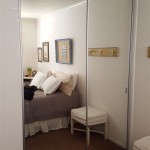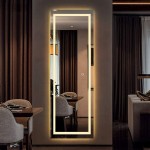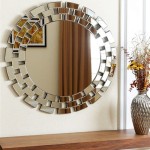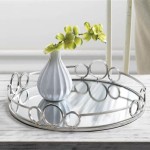How To Hang Up A Mirror With Wire
Hanging a mirror securely and aesthetically pleasing requires careful planning and execution. When dealing with heavier mirrors, utilizing wire provides a robust hanging solution. This article will outline the necessary steps and considerations for successfully hanging a mirror with wire.
Assessing the Mirror and Wall: Before beginning, one must evaluate both the mirror and the intended wall. Determine the mirror's weight to select appropriate hanging hardware. Examine the back of the mirror for existing hardware, such as D-rings or pre-installed wire. The wall material dictates the type of fasteners required. Drywall requires different fasteners than concrete or brick.
Gathering Necessary Materials: Having the correct tools and materials on hand simplifies the process. Typically, this includes a measuring tape, pencil, level, drill (with appropriate drill bits for the wall type), wire cutters, picture hanging wire (rated for the mirror’s weight), D-rings or other appropriate hanging hardware, screws, wall anchors (if necessary), and a stud finder (optional but recommended).
Installing D-Rings or Other Hanging Hardware: If the mirror doesn't have pre-installed hardware, D-rings are a common and effective choice. Position the D-rings equidistant from the center of the mirror's top edge, and approximately one-third of the way down from the top. Mark the placement with a pencil, ensuring the markings are level. Pre-drill holes (if necessary) and securely attach the D-rings using appropriate screws.
Attaching the Wire: Cut a length of picture hanging wire significantly longer than the width of the mirror. This extra length allows for proper wrapping and knot tying. Thread one end of the wire through one D-ring, leaving a tail of several inches. Wrap the wire around itself several times above the D-ring, creating a secure loop. Repeat this process with the other end of the wire and the second D-ring. The wire should form a gentle curve when the mirror is held upright.
Locating and Marking Wall Studs: Locating wall studs provides the most secure anchoring point. Using a stud finder, mark the location of two studs that are appropriately spaced to support the mirror. Ideally, these studs should fall within the area covered by the back of the mirror when hung.
Determining Hook Placement: Hold the mirror against the wall in the desired location. With a pencil, lightly mark the wall through the wire's apex, indicating the ideal hook placement. Measure the distance from the top edge of the mirror to the wire's apex. This measurement, combined with the desired hanging height of the mirror, dictates the precise vertical position of the hooks on the wall.
Installing Hooks or Other Wall Fasteners: Based on wall material and mirror weight, select appropriate hooks or fasteners. For heavy mirrors mounted on drywall, heavy-duty wall anchors are recommended. Align the hooks vertically with the previously marked points, ensuring they are level. Drill pilot holes if necessary, then install the hooks or anchors according to the manufacturer’s instructions.
Hanging the Mirror: Carefully lift the mirror and hang the wire on the installed hooks. Ensure the wire is securely seated on the hooks and the mirror hangs level. Step back and visually inspect the mirror's position and stability.
Adjusting and Securing: Minor adjustments to the wire length can fine-tune the mirror's vertical alignment. If necessary, slightly loosen the wire wrapping on the D-rings, adjust the length, and re-secure the wrapping. Once satisfied with the positioning, double-check the security of all connections.
Alternative Hanging Methods with Wire: While D-rings and hooks are a common method, other options exist. Some mirrors might utilize a single central wire loop. This requires a different type of hook or a picture hanging plate. For very heavy mirrors, French cleat systems may be more appropriate, although these often utilize a combination of wire and a cleat for added stability.
Safety Considerations: Always prioritize safety when hanging heavy objects. Wearing appropriate eye protection during drilling is essential. If unsure about any aspect of the process, consulting a professional handyman or contractor is recommended. Ensuring proper weight ratings for all hardware and fasteners is crucial for preventing accidents and damage.
Choosing the Right Wire: Picture hanging wire comes in various thicknesses and weight capacities. Select a wire that is specifically designed for the weight of the mirror. Using wire that is too thin can lead to breakage and potentially dangerous situations. Consulting the wire packaging for weight guidelines is essential.
Dealing with Uneven Walls: If the wall is uneven, achieving a level hang can be challenging. Shims placed behind the mirror or adjustments to the wire length can help compensate for minor imperfections. In cases of significant wall unevenness, professional assistance may be necessary.

How To Hang A Mirror With Wire Pictures Wikihow
How To Hang A 100 Pound Mirror On Drywall Quora

How To Hang A Mirror With Wire Pictures Wikihow

How To Hang A Mirror With Wire Pictures Wikihow

How To Install Wire On Back Of Mirror

How To Hang A Mirror With Wire Pictures Wikihow

How To Hang A Heavy Mirror Or Picture True Value

How To Tie Wire On Picture Frames

How To Hang A Wall Mirror Easy Mounting Instructions

How To Hang A Heavy Mirror Taskrabbit Blog








